Biology

Anaerobic respiration is a type of respiration that does not use oxygen. It is used when there is not enough oxygen for aerobic respiration.
In the absence of free oxygen:
Two other pathways allow the recycling of reduced NAD formed during glycolysis:
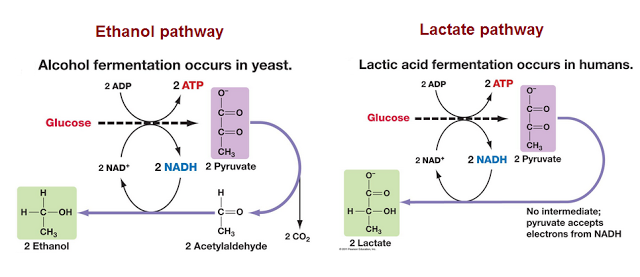
? Ethanol pathway: conversion of pyruvate to ethanol in alcoholic fermentation, e.g. by yeast
? Lactate pathway: conversion of pyruvate to lactate (lactic acid), e.g. by mammalian muscle.
1. The ethanol pathway
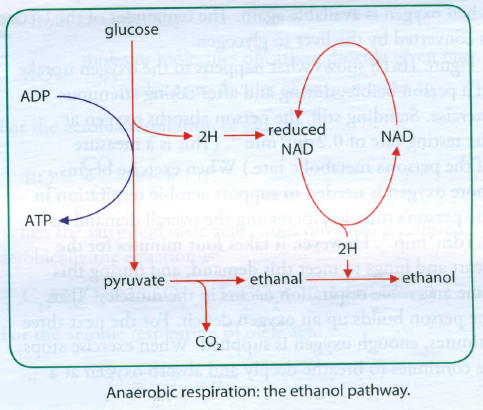
In yeast and in plants, the pyruvate is removed by converting it to ethanol.
- Pyruvate is decarboxylated to acetaldehyde/ethanal (CH3CHO).
- This accepts hydrogen from reduced NAD and is reduced to ethanol (C2H5OH), releasing NAD.

2. The lactate pathway
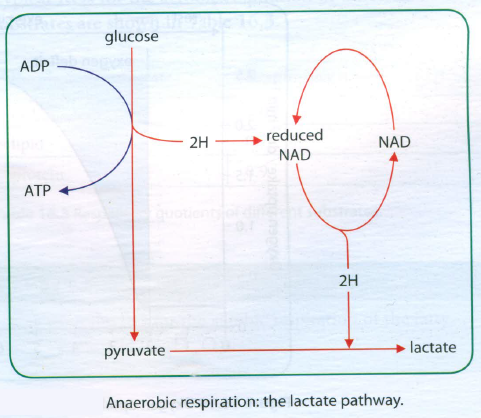
In mammalian muscles that are deprived of oxygen, pyruvate itself acts as the hydrogen acceptor and is removed by converting it to lactate. Again, NAD is released.

The Cori cycle
In mammals, lactate produced during strenuous muscle activity is taken up from blood plasma by the liver, where it is converted to pyruvate and thence to glucose or glycogen.
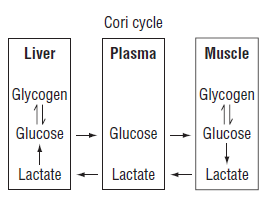
The Cori cycle serves two purposes:
? it ?rescues? lactate and prevents the wasteful loss of some of its chemical bond energy
? it prevents a potentially disastrous fall in plasma pH.
The lactate that is produced in muscles diffuses into the blood and is carried in solution in the blood plasma to the liver. Here, liver cells convert it back to pyruvate. This requires oxygen, so extra oxygen is required after exercise has finished. The extra oxygen is known as the oxygen debt.
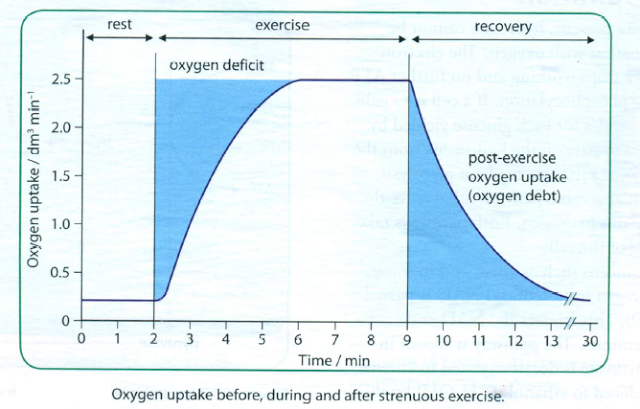
Later, when the exercise has finished and oxygen is available again, some of the pyruvate in the liver cells is oxidised through the link reaction, the Krebs cycle and the electron transport chain. Some of the pyruvate is reconverted to glucose in the liver cells. The glucose may be released into the blood or converted to glycogen and stored.
 Note:
Note:
? Both reactions ?buy time? by providing hydrogen acceptors so that NAD is released and glycolyis can continue.
? Both pathways are inefficient and wasteful in that the products (ethanol or lactate) have chemical bond energy that is untapped.
? The ethanol or lactate produced is toxic and restricts the use of the pathways.
? While the lactate pathway is reversible (by the Cori cycle) in the mammalian liver, the ethanol pathway is irreversible.
? There is a net gain of only two ATP molecules per glucose molecule (from glycolysis) during anaerobic respiration.
- Q: Explain The Small Yield Of Atp From Anaerobic Respiration
In the absence of oxygen, the conversion of pyruvate to acetyl CoA, the Krebs cycle, and oxidative phosphorylation are prevented as oxygen is not available as the final electron acceptor. Hence, only glycolysis can occur, generating 2 molecules of ATP...
- #97 Summary Of Energy And Respiration
1 Organisms must do work to stay alive. The energy input necessary for this work is either light, for photosynthesis, or the chemical potential energy of organic molecules. Work includes anabolic reactions, active transport and movement. Some organisms,...
- #88 Aerobic Respiration, Link Reaction
If oxygen is available, each pyruvate now moves into a mitochondrion, where the link reaction and the Krebs cycle take place. During these processes, the glucose is completely oxidised. The link reaction In the link reaction, pyruvate enters the...
- #85 Energy And Respiration - Syllabus 2016
12.1 Energy12.2 Respiration Energy is a fundamental concept in biology. All living things require a source of cellular energy to drive their various activities. ATP is the universal energy currency as its molecules are small,...
- Q & A
Questions Plants derive energy from the _____________ of Glucose into __________. The time in which a cell oxidizes glucose is known as______. The oxidation of glucose into pyruvate is a process known as__________. What is the energy released during glycolysis...
Biology
# 91 Anaerobic respiration - Ethanol and Lactate pathways

Anaerobic respiration is a type of respiration that does not use oxygen. It is used when there is not enough oxygen for aerobic respiration.
In the absence of free oxygen:
- Oxidative phosphorylation cannot take place, as there is nothing to accept the electrons and protons at the end of the electron transport chain.
- Hydrogen cannot be used up by combining it with oxygen to give water, so reduced NAD cannot be recycled to NAD in this way to allow glycolysis to continue.
- The mitochondrion quickly runs out of NAD or FAD that can accept hydrogens from the Krebs cycle reactions. The Krebs cycle and the link reaction therefore come to a halt.
- Glycolysis, however, can still continue, so long as the pyruvate produced at the end of it can be removed and the reduced NAD can be converted back to NAD.
Two other pathways allow the recycling of reduced NAD formed during glycolysis:

? Ethanol pathway: conversion of pyruvate to ethanol in alcoholic fermentation, e.g. by yeast
? Lactate pathway: conversion of pyruvate to lactate (lactic acid), e.g. by mammalian muscle.

In yeast and in plants, the pyruvate is removed by converting it to ethanol.
- Pyruvate is decarboxylated to acetaldehyde/ethanal (CH3CHO).
- This accepts hydrogen from reduced NAD and is reduced to ethanol (C2H5OH), releasing NAD.

2. The lactate pathway

In mammalian muscles that are deprived of oxygen, pyruvate itself acts as the hydrogen acceptor and is removed by converting it to lactate. Again, NAD is released.

In mammals, lactate produced during strenuous muscle activity is taken up from blood plasma by the liver, where it is converted to pyruvate and thence to glucose or glycogen.

? it ?rescues? lactate and prevents the wasteful loss of some of its chemical bond energy
? it prevents a potentially disastrous fall in plasma pH.
The lactate that is produced in muscles diffuses into the blood and is carried in solution in the blood plasma to the liver. Here, liver cells convert it back to pyruvate. This requires oxygen, so extra oxygen is required after exercise has finished. The extra oxygen is known as the oxygen debt.


? Both reactions ?buy time? by providing hydrogen acceptors so that NAD is released and glycolyis can continue.
? Both pathways are inefficient and wasteful in that the products (ethanol or lactate) have chemical bond energy that is untapped.
? The ethanol or lactate produced is toxic and restricts the use of the pathways.
? While the lactate pathway is reversible (by the Cori cycle) in the mammalian liver, the ethanol pathway is irreversible.
? There is a net gain of only two ATP molecules per glucose molecule (from glycolysis) during anaerobic respiration.
Syllabus: 12.2 Respiration k) explain the production of a small yield of ATP from respiration in anaerobic conditions in yeast and in mammalian muscle tissue, including the concept of oxygen debt |
- Q: Explain The Small Yield Of Atp From Anaerobic Respiration
In the absence of oxygen, the conversion of pyruvate to acetyl CoA, the Krebs cycle, and oxidative phosphorylation are prevented as oxygen is not available as the final electron acceptor. Hence, only glycolysis can occur, generating 2 molecules of ATP...
- #97 Summary Of Energy And Respiration
1 Organisms must do work to stay alive. The energy input necessary for this work is either light, for photosynthesis, or the chemical potential energy of organic molecules. Work includes anabolic reactions, active transport and movement. Some organisms,...
- #88 Aerobic Respiration, Link Reaction
If oxygen is available, each pyruvate now moves into a mitochondrion, where the link reaction and the Krebs cycle take place. During these processes, the glucose is completely oxidised. The link reaction In the link reaction, pyruvate enters the...
- #85 Energy And Respiration - Syllabus 2016
12.1 Energy12.2 Respiration Energy is a fundamental concept in biology. All living things require a source of cellular energy to drive their various activities. ATP is the universal energy currency as its molecules are small,...
- Q & A
Questions Plants derive energy from the _____________ of Glucose into __________. The time in which a cell oxidizes glucose is known as______. The oxidation of glucose into pyruvate is a process known as__________. What is the energy released during glycolysis...
